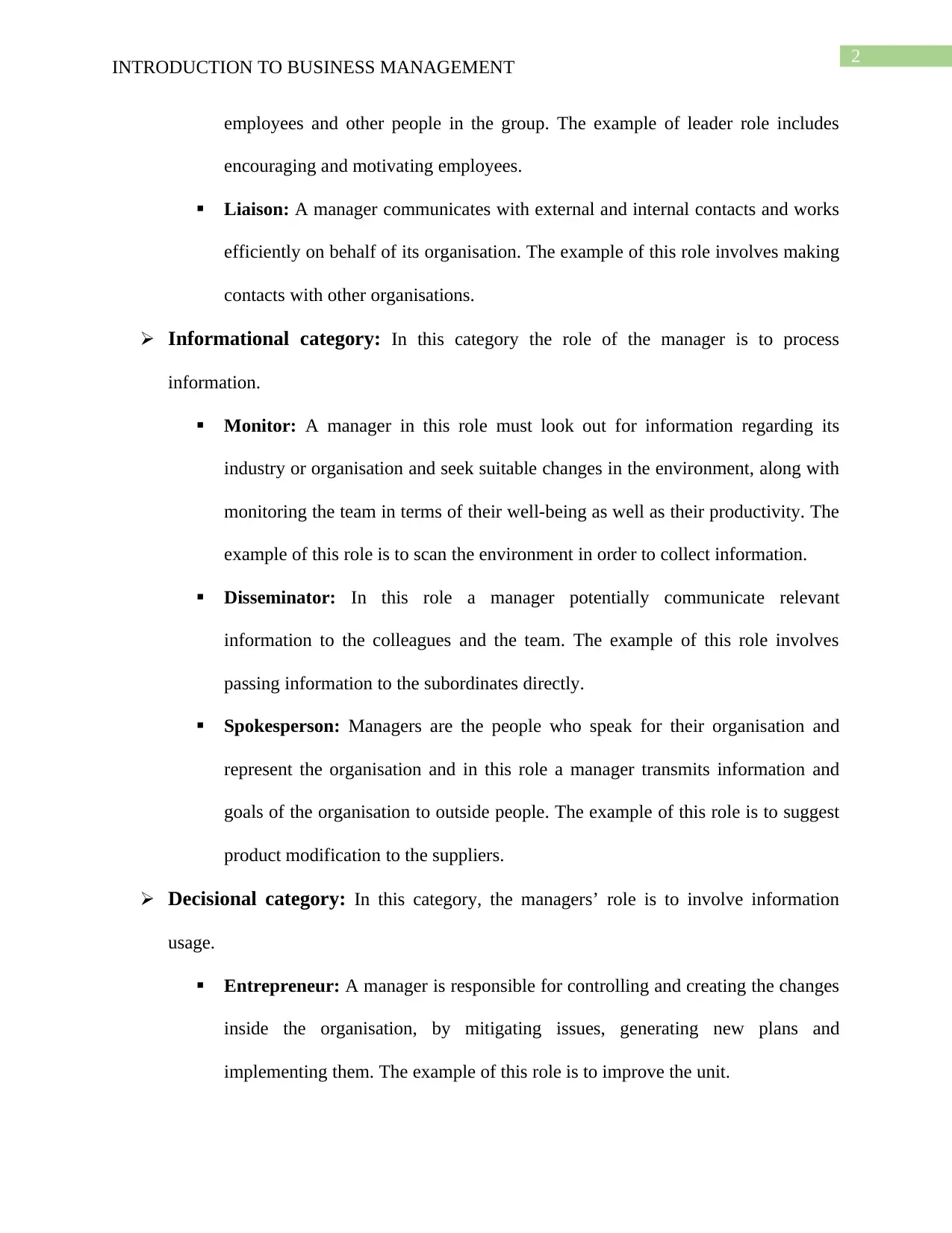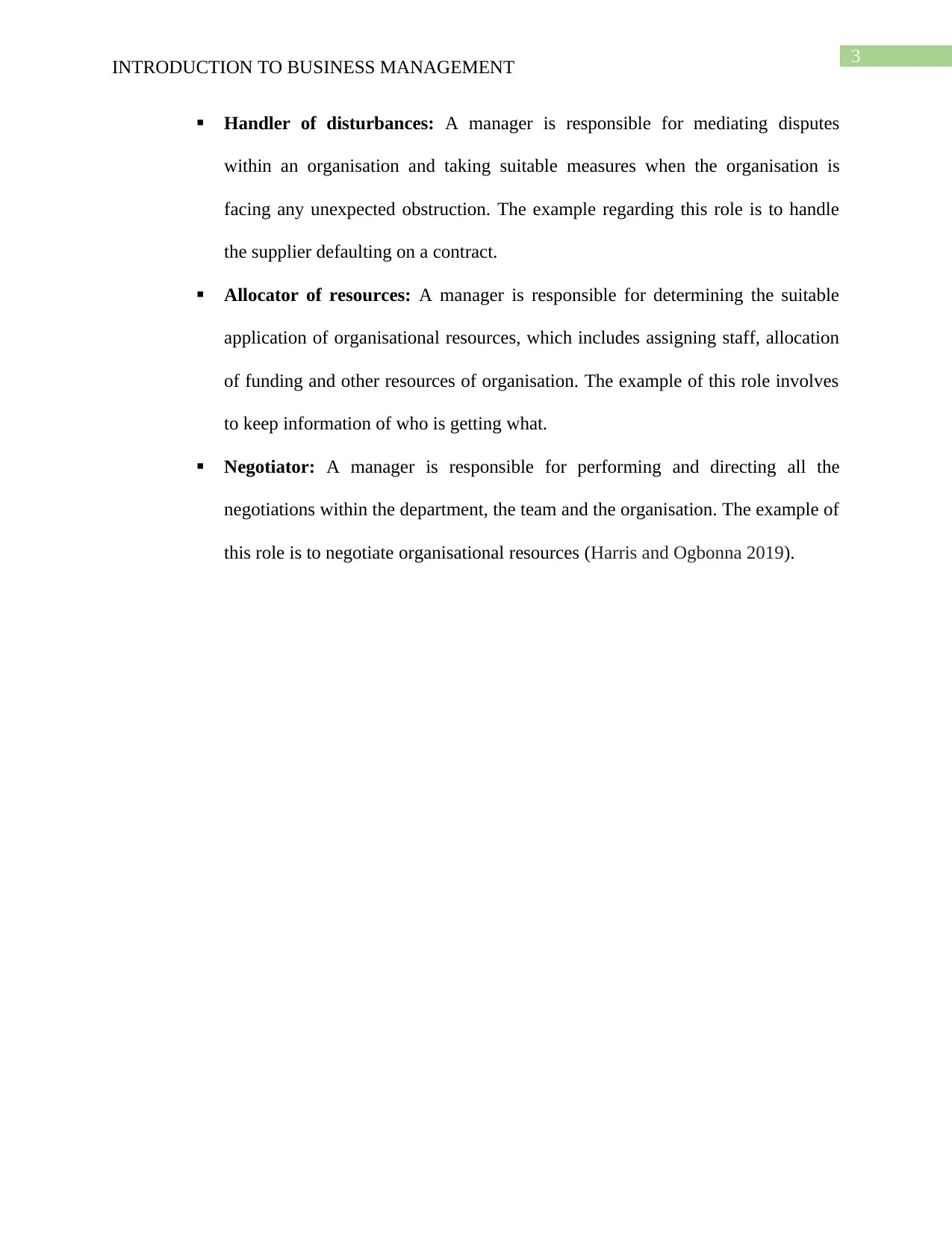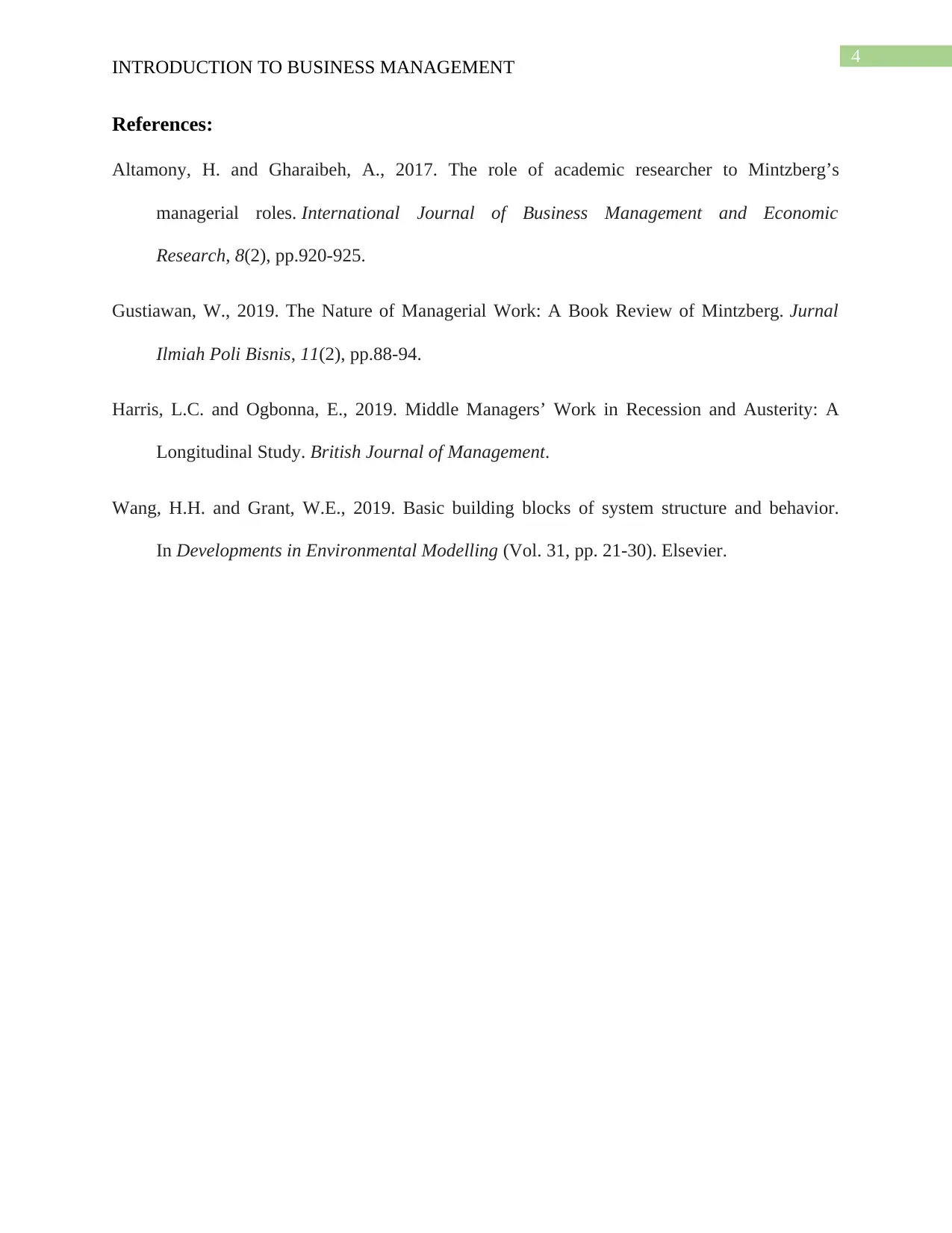Introduction to Business Management: System and Manager Roles
VerifiedAdded on 2022/08/29
|5
|790
|14
Homework Assignment
AI Summary
This assignment addresses key concepts in business management, specifically focusing on system characteristics and Mintzberg's managerial roles. The first part of the assignment discusses five fundamental characteristics of a basic system: organization, interaction, interdependence, integration, and primary objective, providing examples for each. The second part delves into Mintzberg's ten managerial roles, categorizing them into interpersonal, informational, and decisional roles. Each role is thoroughly explained with relevant examples, offering a comprehensive overview of the complexities of a manager's job. The assignment includes references to support the discussed concepts.

Running head: INTRODUCTION TO BUSINESS MANAGEMENT
INTRODUCTION TO BUSINESS MANAGEMENT
Name of the Student
Name of the University
Authors note
INTRODUCTION TO BUSINESS MANAGEMENT
Name of the Student
Name of the University
Authors note
Paraphrase This Document
Need a fresh take? Get an instant paraphrase of this document with our AI Paraphraser

1
INTRODUCTION TO BUSINESS MANAGEMENT
Answer 1:
Following are the five characteristics of a basic system (Wang and Grant 2019):
Organization: This is the arrangement of components that helps in terms of acquiring
the objectives. The implicit of structure and order.
Interaction: This is the way through which one component of the system functions with
the other. Example:
Inter-dependence: This term refers to the coordination of components within a system.
Integration: This term refers to the aggregation or of systems.
Primary objective: This helps in functioning of the system and maintaining the
consistency.
Answer 2:
Mintzberg has published his Ten Management Roles in his book named, “Mintzberg on
Management” in the year 1990, which are divided under three different categories (Altamony
and Gharaibeh 2017):
Interpersonal category: The roles of management under this category includes ideas
and information (Gustiawan 2019).
Figurehead: A manager have legal, social and ceremonial responsibilities. A
manager is expected to be an inspirational source. People look up to a manager as
an individual with authority. The example of this particular managerial role
involves a senior executive greeting visiting dignitaries.
Leader: A manager plays the role of a leader for its department, its team and also
its whole organisation, and it also plays the role of supervising the performance of
INTRODUCTION TO BUSINESS MANAGEMENT
Answer 1:
Following are the five characteristics of a basic system (Wang and Grant 2019):
Organization: This is the arrangement of components that helps in terms of acquiring
the objectives. The implicit of structure and order.
Interaction: This is the way through which one component of the system functions with
the other. Example:
Inter-dependence: This term refers to the coordination of components within a system.
Integration: This term refers to the aggregation or of systems.
Primary objective: This helps in functioning of the system and maintaining the
consistency.
Answer 2:
Mintzberg has published his Ten Management Roles in his book named, “Mintzberg on
Management” in the year 1990, which are divided under three different categories (Altamony
and Gharaibeh 2017):
Interpersonal category: The roles of management under this category includes ideas
and information (Gustiawan 2019).
Figurehead: A manager have legal, social and ceremonial responsibilities. A
manager is expected to be an inspirational source. People look up to a manager as
an individual with authority. The example of this particular managerial role
involves a senior executive greeting visiting dignitaries.
Leader: A manager plays the role of a leader for its department, its team and also
its whole organisation, and it also plays the role of supervising the performance of

2
INTRODUCTION TO BUSINESS MANAGEMENT
employees and other people in the group. The example of leader role includes
encouraging and motivating employees.
Liaison: A manager communicates with external and internal contacts and works
efficiently on behalf of its organisation. The example of this role involves making
contacts with other organisations.
Informational category: In this category the role of the manager is to process
information.
Monitor: A manager in this role must look out for information regarding its
industry or organisation and seek suitable changes in the environment, along with
monitoring the team in terms of their well-being as well as their productivity. The
example of this role is to scan the environment in order to collect information.
Disseminator: In this role a manager potentially communicate relevant
information to the colleagues and the team. The example of this role involves
passing information to the subordinates directly.
Spokesperson: Managers are the people who speak for their organisation and
represent the organisation and in this role a manager transmits information and
goals of the organisation to outside people. The example of this role is to suggest
product modification to the suppliers.
Decisional category: In this category, the managers’ role is to involve information
usage.
Entrepreneur: A manager is responsible for controlling and creating the changes
inside the organisation, by mitigating issues, generating new plans and
implementing them. The example of this role is to improve the unit.
INTRODUCTION TO BUSINESS MANAGEMENT
employees and other people in the group. The example of leader role includes
encouraging and motivating employees.
Liaison: A manager communicates with external and internal contacts and works
efficiently on behalf of its organisation. The example of this role involves making
contacts with other organisations.
Informational category: In this category the role of the manager is to process
information.
Monitor: A manager in this role must look out for information regarding its
industry or organisation and seek suitable changes in the environment, along with
monitoring the team in terms of their well-being as well as their productivity. The
example of this role is to scan the environment in order to collect information.
Disseminator: In this role a manager potentially communicate relevant
information to the colleagues and the team. The example of this role involves
passing information to the subordinates directly.
Spokesperson: Managers are the people who speak for their organisation and
represent the organisation and in this role a manager transmits information and
goals of the organisation to outside people. The example of this role is to suggest
product modification to the suppliers.
Decisional category: In this category, the managers’ role is to involve information
usage.
Entrepreneur: A manager is responsible for controlling and creating the changes
inside the organisation, by mitigating issues, generating new plans and
implementing them. The example of this role is to improve the unit.
⊘ This is a preview!⊘
Do you want full access?
Subscribe today to unlock all pages.

Trusted by 1+ million students worldwide

3
INTRODUCTION TO BUSINESS MANAGEMENT
Handler of disturbances: A manager is responsible for mediating disputes
within an organisation and taking suitable measures when the organisation is
facing any unexpected obstruction. The example regarding this role is to handle
the supplier defaulting on a contract.
Allocator of resources: A manager is responsible for determining the suitable
application of organisational resources, which includes assigning staff, allocation
of funding and other resources of organisation. The example of this role involves
to keep information of who is getting what.
Negotiator: A manager is responsible for performing and directing all the
negotiations within the department, the team and the organisation. The example of
this role is to negotiate organisational resources (Harris and Ogbonna 2019).
INTRODUCTION TO BUSINESS MANAGEMENT
Handler of disturbances: A manager is responsible for mediating disputes
within an organisation and taking suitable measures when the organisation is
facing any unexpected obstruction. The example regarding this role is to handle
the supplier defaulting on a contract.
Allocator of resources: A manager is responsible for determining the suitable
application of organisational resources, which includes assigning staff, allocation
of funding and other resources of organisation. The example of this role involves
to keep information of who is getting what.
Negotiator: A manager is responsible for performing and directing all the
negotiations within the department, the team and the organisation. The example of
this role is to negotiate organisational resources (Harris and Ogbonna 2019).
Paraphrase This Document
Need a fresh take? Get an instant paraphrase of this document with our AI Paraphraser

4
INTRODUCTION TO BUSINESS MANAGEMENT
References:
Altamony, H. and Gharaibeh, A., 2017. The role of academic researcher to Mintzberg’s
managerial roles. International Journal of Business Management and Economic
Research, 8(2), pp.920-925.
Gustiawan, W., 2019. The Nature of Managerial Work: A Book Review of Mintzberg. Jurnal
Ilmiah Poli Bisnis, 11(2), pp.88-94.
Harris, L.C. and Ogbonna, E., 2019. Middle Managers’ Work in Recession and Austerity: A
Longitudinal Study. British Journal of Management.
Wang, H.H. and Grant, W.E., 2019. Basic building blocks of system structure and behavior.
In Developments in Environmental Modelling (Vol. 31, pp. 21-30). Elsevier.
INTRODUCTION TO BUSINESS MANAGEMENT
References:
Altamony, H. and Gharaibeh, A., 2017. The role of academic researcher to Mintzberg’s
managerial roles. International Journal of Business Management and Economic
Research, 8(2), pp.920-925.
Gustiawan, W., 2019. The Nature of Managerial Work: A Book Review of Mintzberg. Jurnal
Ilmiah Poli Bisnis, 11(2), pp.88-94.
Harris, L.C. and Ogbonna, E., 2019. Middle Managers’ Work in Recession and Austerity: A
Longitudinal Study. British Journal of Management.
Wang, H.H. and Grant, W.E., 2019. Basic building blocks of system structure and behavior.
In Developments in Environmental Modelling (Vol. 31, pp. 21-30). Elsevier.
1 out of 5
Related Documents
Your All-in-One AI-Powered Toolkit for Academic Success.
+13062052269
info@desklib.com
Available 24*7 on WhatsApp / Email
![[object Object]](/_next/static/media/star-bottom.7253800d.svg)
Unlock your academic potential
Copyright © 2020–2025 A2Z Services. All Rights Reserved. Developed and managed by ZUCOL.





